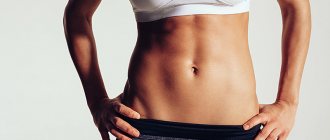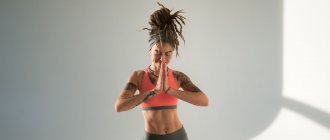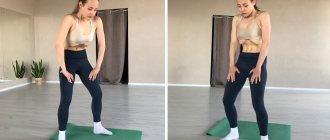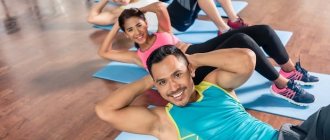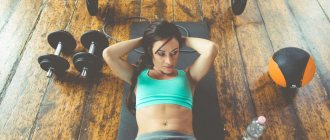The abdominal muscles form the anterior wall of the abdominal cavity and are in close interaction with each other. The structure of the abdominal wall can be divided into two parts, each of which acts differently. The anterior wall of the abdominal cavity is formed by the rectus abdominis muscle. The lateral walls of the abdomen consist of three layers of muscles. The lowest layer is formed by the transverse muscle. The middle layer is formed by the internal oblique abdominal muscle. At the very top is the external oblique abdominal muscle.
Contraction of the oblique abdominal muscles on one side of the body causes a lateral tilt of the torso. The simultaneous contraction of the oblique muscles on both sides helps the rectus abdominis muscle tilt the torso forward and at the same time gives strength to the walls of the abdominal cavity if there is a need to lift heavy weights.
General functions of the abdominal muscles
- When fixing the pelvis, the torso is tilted forward or backward.
- When fixing the upper body, bend and raise the legs.
- When fixing the pelvis and spine, pull the chest down, facilitating exhalation.
- Helps increase the active strength of the muscles extending from the pelvis to the lower extremities.
- They have a great influence on keeping the abdominal organs in the correct position.
- They are antagonists of the rectifiers of the trunk, affecting posture.
Abs secrets
♦ The abdominal muscles are classified as endurance muscles, so they cannot be created by doing 8 repetitions like the arms, chest or back; to tire them out, you need to perform a large number of repetitions, do at least 25-40 times, with a feeling of the muscle and strict adherence to technique .
♦ If you want clearly defined muscles, while maintaining a narrow waist, forget about exercising with additional weights (dumbbells in your hands, weights on your legs or a weight on your neck), so you, of course, will build abdominal muscles and you will have cubes, but your waist will increase in volume. Do a lot of reps with your own weight, the build period may be longer, but the results will be worth it.
♦ Follow a diet, otherwise all the fruits of your labor will be hidden under fat deposits, consume more vitamins and minerals, plenty of proteins, moderate carbohydrates and minimize fat intake.
♦ If at the end of the exercise you feel a burning sensation in your abs, as if something was squeezing your stomach, then everything was done correctly, your back hurts - replace the exercise, you don’t feel the muscle - you are violating the technique or not finishing it to the end.
♦ It’s better to do fewer repetitions and better quality than a lot, but whatever.
Beautiful abs are not a myth, but a reality, take care of yourself and you yourself will be surprised by the effect achieved.
INTERNAL OLIQUE ABDOMINUS MUSCLE
The internal oblique muscle is also located anterior to the sides of the midline of the abdomen and runs diagonally from the pelvis to the chest. It is located under the external oblique muscle of the abdomen and the fibers of both muscles are located at right angles to each other. Like the transverse muscle, the internal oblique muscle originates from the fifth, sixth, seventh ribs and ends at the pubic bone.
Diaphragm and perineal muscles
The diaphragm separates the chest and abdominal cavities and is a thin muscle curved into a dome. The muscle bundles of the diaphragm begin from the upper lumbar vertebrae, lower ribs and sternum and converge to the tendon center, which forms the dome of the diaphragm. The diaphragm has openings for the esophagus, large vessels and nerves. During inhalation, the dome of the diaphragm flattens, causing the chest cavity to expand (which causes the lungs to expand), and the pressure in the abdominal cavity increases.
The perineal muscles form the floor of the pelvis and serve as support for the insides. The anterior part of the perineum is called the urogenital diaphragm, the posterior part is called the pelvic diaphragm. The muscles of the urogenital diaphragm in men surround the corpus spongiosum of the penis (and the urethra passing through it), and in women - the urethra and the opening of the vagina. The anus is located in the center of the pelvic diaphragm. Supporting the abdominal organs from below, the muscles of the perineum function simultaneously as sphincters (compressors) of the anus and urethra. To strengthen the pelvic floor, the muscles are arranged in several layers and woven into the tendon center of the perineum, which is formed by bundles of dense connective tissue and is located under the skin between the external genitalia and the anus.
RECTUS ABDOMINUS MUSCLE
The rectus abdominis muscle starts from the lower edge of the chest and sternum and runs vertically downward, attaching to the pubic bone. The two halves of this muscle (right and left) are separated in the middle by a layer of connective tissue called the linea alba. Layers of this connective tissue give the rectus abdominis muscle a characteristic relief in the form of convex rectangles. The rectus abdominis muscle is responsible for bending forward. This movement is accomplished by contracting either the upper part of the muscle, which pulls the chest toward the pelvis, or the lower part, which lifts the pelvis toward the chest.
The rectus abdominis muscle is divided down the middle by a groove that disappears below the navel as the two halves of the muscle move closer to each other. Along its course, the muscle has three or four tendon bridges, dividing it into convex sections that can contract one independently of the other.
Workout Features
Taking into account the functional features, we can say that in the training process some of the groups are not affected by classical exercises.
Therefore, it is worth understanding the main postulates of the training process:
- It is impossible to burn the fat layer in the abdominal area. It is either consumed throughout the body or not consumed at all. Therefore, between strength training, on free days, do aerobics and cardio training.
- Strength exercises in one approach should not exceed 15 repetitions. Otherwise, then we are no longer talking about hypertrophy of muscle tissue, but about an endurance test.
- To engage the internal muscles, you should do “vacuum” exercises. They help reduce waist size, tighten the internal structures of the flesh and get a beautiful abdominal shape.
Knowing the anatomical structure of the abdominal muscles and functional features, you will be able to take a more competent and responsible approach to your own training and building a personal complex for beautiful abs. Moreover, this will make training more effective. The abdominal region has been 100% examined, so every person is able to find out not only the name, but also the location of the muscle on the anatomical atlas of the body.
EXTERNAL OLIQUE ABDOMINUS MUSCLE
The external oblique is a thin, flat, broad muscle that starts at the lower ribs and runs forward and down. It runs diagonally from the chest to the pelvis, where it attaches to the ilium and, in the middle, to the linea alba. The muscle roll of the external oblique muscle of the abdomen in people with well-developed muscles forms the lower border of the abdomen. The external oblique muscle is clearly visible through the skin. When you look at the abdominal muscles, this is the muscle you see.
By working the external oblique muscle, you simultaneously develop the serratus anterior muscle, which forms part of the side wall of the chest. Its serrated edge emerges from under the pectoralis major muscle and connects with the finger-like outgrowths of the external oblique abdominal muscle.
Trained abdominal muscles ensure fixation of internal organs, correct posture, and a beautiful appearance. Muscles that have lost elasticity may succumb to pressure from internal organs. If you become slightly overweight, fat may be deposited in the abdominal area. The depth of the navel indicates a layer of subcutaneous fat.
To effectively work the abdominal muscles, it is necessary to perform exercises that affect all the muscles in this area. Body lifts are designed for the muscles of the upper abdomen. For the muscles of the lower section - leg lifting and reverse twisting. Finally, for the muscles of the side walls of the abdomen, perform turns and bends to the sides.
If you are trying to get rid of excess fat in the abdominal area, then you should not overuse abdominal exercises alone. This will not bring the desired effect, since fat burning is a complex process that requires both strength exercises and proper nutrition in combination with aerobic exercise.
The structure of the abdominal region
The location and functions of the abdominal muscles in humans are closely interrelated. This area is divided into four types:
- Rectus abdominis muscles. They are attached to the cartilaginous tissues of the 5-7 ribs, the pubic bone and the xiphoid process of the chest.
- The external oblique is attached to the pubic symphysis, the outer surface of the 5-12 ribs, and the iliac crest.
- The transverse is attached to the iliac crest and the lateral third of the ligament in the groin.
- The internal oblique muscle is attached to the iliac crest and the cartilaginous tissue of the lower ribs.
Now it’s worth considering each group separately, as well as why they are in the body.
Video
Rectus muscle
This long abdominal muscle belongs to the anterior abdominal cavity. It starts from the pubic crest and extends to the very top of the abdomen, where it is attached to the sternum with the ribs.
Please note: It is visible when pumping the press. The so-called “cubes” of the press are formed because these tissues are crossed transversely by tendon bridges.
These rectus muscles, in addition to the aesthetic load, are responsible for bending the torso forward and pulling the ribs down. They also lift the pelvis if the chest is fixed. These abdominal muscles, which form the abdominal press, are worked most often and are involved in the work when performing many exercises not only for the abdomen, but also for the hips and back.
Oblique muscles
The oblique muscles of the peritoneum are located on both sides of the human body. They are responsible for turns. They are divided into internal and external. The internal ones are located deep and stretch from the sternum to the pelvis. The external ones are located directly under the skin above the internal ones. Thanks to them, the body bends and twists (accordingly, oblique exercises are called twisting). Moreover, their action is symmetrical. That is, for example, when twisting to the left side, the left external and right internal abdominal muscles work. Based on the name, it becomes clear that their arrangement is oblique. Together with the rectus abdominis muscles, the obliques help stabilize the spinal column by increasing intra-abdominal pressure. Therefore, the spine remains healthy and functions normally. Also, the lateral press helps maintain the internal organs in the desired position.
Obliques are also called stabilizers (as are lumbar). By strengthening them, you can maintain or correct your posture and return your spine to its natural position. Any complex movement begins with the work of the lateral press, and only after that the activity moves to other departments. Strengthening the oblique abdominal muscles is a must to keep them in good shape. Otherwise, asymmetry occurs in the waist area, an imbalance in the development of this muscle group.
Please note: When the goal is to get beautiful abs, you need to remember that not only pumping is important in this matter. If the fat layer is more than 1.5 cm, then the results will not be visible. Therefore, all loads should be not only for hypertrophy of the oblique and rectus muscles, but also for the reduction of fatty tissues located under the skin.
The external oblique muscles are the largest muscles visible in the abdominal region. They are responsible not only for twisting and bending, but also for carrying and lifting heavy objects. They are the only ones in continuous activity, even when a person is standing, responsible for maintaining balance. They provide support to the lower back and spinal column during a variety of movements. The internal oblique muscles, when contracted bilaterally, flex the spine.
Video
If the contraction is one-sided, then either the body is rotated or the ribs are lowered. The attachment of the oblique muscles occurs on the intermediate line at the iliac crest, the area of the lumbothoracic fascia and on the inguinal ligament (its lateral part). The lower beams are directed both down and up. they become a wide aponeurosis along a contour drawn to the pubic bone from the cartilage on the rib. The lower bundles of this muscle in men are included in the spermatic cord, responsible for raising the testicle.
Transversus muscle
The transverse is the third and deepest layer of the peritoneal musculature. The bunches of this group are arranged horizontally, passing from behind and forward, going around the waist. When it contracts, it helps reduce the size of the peritoneal cavity by retracting the abdomen and pulling the ribs toward the midline.
Home workout program
At home, the principles of building a program are no different from training in the gym. Only the exercises change.
Program for training the abs once a week:
| Exercise name | Abdominal muscles involved | Number of approaches and repetitions | Photo |
| Straight crunches on the floor | Straight | 3x12-15 | |
| Reverse crunches on the floor | Straight | 3x10-15 |
|
| Crunches with legs raised | Straight | 3x10-15 |
|
| V-turns | Oblique | 3x8-12 |
|
| Lateral bends | Oblique | 3x12-15 |
|
Three day program. First workout:
| Exercise name | Abdominal muscles involved | Number of approaches and repetitions | Photo |
| Sitap | Straight | 3x10-15 | |
| Running while lying down | Straight | 3x10-15 |
|
| Side crunches | Oblique | 4x12-15 |
Second:
| Exercise name | Abdominal muscles involved | Number of approaches and repetitions | Photo |
| Crunches on the floor | Straight | 3x12-15 | |
| Reverse crunches on the floor | Straight | 3x10-15 | © artinspiring — stock.adobe.com |
| Leg raises lying on your side | Oblique | 3x12-15 |
|
Third:
| Exercise name | Abdominal muscles involved | Number of approaches and repetitions | Photo |
| Elbow plank | Straight | 3x60-90 sec |
|
| Rolling out on a roller for the press | Straight | 3x10-12 |
|
| Hanging pelvic rotations | Oblique | 3x10-15 |
|
Recipes for healthy eating
Salad with shrimps and vegetables
- 7.8 g Protein
- 2.4 g Fat
- 2.5 g Carbohydrates
- 78.9 kcal
30-40 min.
- #dietary
- #green onions
- #shrimps
- #corn
- #honey
- #low calorie
- #dinner
- #vegetables
- #parsley
- #tomato
- #salad
- #sour cream
- #spices
- #dinner
- #beans
- #garlic
Other recipes
Nuances of training for women
Most often, guys and girls who work out in the gym do the same abdominal exercises. The structure of this muscle zone is identical in representatives of different sexes. Thus, women can benefit from any available abdominal exercise.
However, it should be noted that there are still several features of the training process for the fair sex:
- You need to perform only those movements that do not cause any discomfort, pain or other unpleasant sensations (this is also true for men).
- Girls should exercise without the help of heavy sports equipment. Strength work can lead to an enlarged waist, which is unlikely to be the effect you were looking for.
- Do not strive to complete complex tasks, focus on simple exercises that will help you work the target muscle group comprehensively. Simple does not mean ineffective.
- Women do not necessarily need to specifically focus on movements that are designed to pump up the lateral abdominal muscles - exercises on the rectus abdominis muscle will be quite enough.
Abdominal diseases
Prolapse of the viscera is the downward displacement of the abdominal organs when the body is in an upright position. The main reason is weakening of the muscle tone of the abdominal wall, sometimes sudden weight loss. The displacement is accompanied by stretching of the organs, their bending and leads to dysfunction and pain. Prolapse of the stomach and intestines causes a feeling of heaviness in the abdomen, pain, belching, nausea and constipation. Prolapse of the kidney leads to kinking of the ureter, impaired passage of urine and attacks of renal colic. Prolapse of the uterus occurs when intra-abdominal pressure increases (due to strong straining, when lifting heavy objects) against the background of weakness of the muscles of the perineum and abdomen. In this case, the internal genital organs are displaced downward.
A hernia is the release of internal organs (parts of the intestines, stomach, greater omentum, ovary) from the abdominal cavity under the skin of the abdomen. The causes of hernias are muscle weakness or sudden weight loss, combined with a prolonged increase in intra-abdominal pressure: prolonged constipation and a tendency to flatulence, heavy lifting, and in infants - crying.
Hernias can occur when the fibers of the linea alba (above the navel) separate. Umbilical hernias most often develop in children and women, and hernias of the white line - in men. The most common type of hernia is inguinal hernia, in which the insides exit through the inguinal canal under the skin in the lower abdomen. The inguinal canal is a narrow gap in the lower part of the anterior abdominal wall. In men, the spermatic cord passes through here, and in women, the round ligament of the uterus passes through. In boys, the testicles descend from the abdominal cavity into the scrotum through the inguinal canal shortly before birth. Inguinal hernias in boys can occur due to improper development of the inguinal canal and delayed descent of the testicles. In some inguinal hernias, loops of intestine penetrate the scrotum, and then they speak of scrotal hernias.
In femoral hernias, which are more common in women, the viscera exits the abdominal cavity through the femoral canal, the site where the large vessels of the leg pass from the abdominal cavity to the thigh.
A special place is occupied by postoperative hernias that occur in the area of scars if the wound has been healing for a long time with symptoms of suppuration. Hernias can also occur in the upper wall of the abdominal cavity, which is formed by the diaphragm. A diaphragmatic hernia containing the upper part of the stomach can exit through the esophageal opening into the chest cavity. Hernias are dangerous because they can be strangulated. When straining or straining, the gap through which the internal organs emerged (for example, an intestinal loop in an inguinal hernia) narrows, compressing the organ and the vessels feeding it. If medical attention is not provided in a timely manner, intestinal obstruction, necrosis of the intestinal wall and peritonitis may develop.
Common Injuries
It is very important to perform all movements with correct technique and also to work at a slow pace. Before starting the class, you should warm up well. Warm up not only your oblique muscles, but other parts of your body as well. This way you can avoid troubles and various injuries.
So, what injuries can result from improper exercise technique? Let's look at the most common problems, their causes and symptoms:
- The most common injury is a sprain. Athletes suffer similar damage during intense training. The structure of muscle tissue may be disrupted. If you feel sharp pain in the abdominal area and it is unpleasant to bend your body, consult a doctor. In some cases, athletes suffer from bruising. Your body temperature may rise. The duration of the recovery process depends entirely on the severity of the injury.
- Regular aching pain can occur if you exercise too often and too much. The athlete must rest well between training sessions to avoid the effects of overtraining. You don't need to pump up your abs every day .
- Pain in the abdominal area does not always occur due to errors in the technique. You could simply have been blown away. Be sure to consult a doctor if the problem cannot be solved on your own by reducing the frequency, intensity of training and reducing the load. An experienced specialist will be able to make the correct diagnosis and prescribe treatment.


